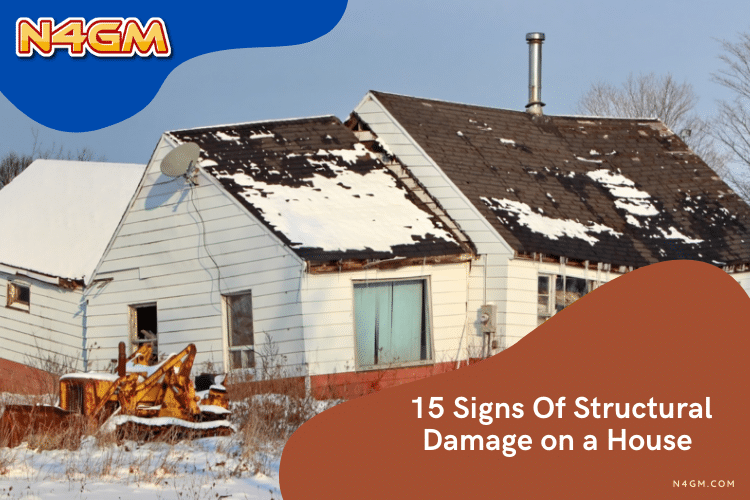When we talk about structural damage on a house, it is a particular type of architecture engineering in which we mainly deal with the core integrity of the home; specific areas of concern are roofs and walls.
As we know that load-bearing walls are the essential part of the home as they carry most of the weight of your home; without these dynamic and robust walls, ultimately, your home will be collapsed.
So here in this article, we will discuss all the structural damage to the house.
What are signs of structural damage to the house in the UK?
When we talk about the symptoms of structural damage, there are so many signs through which you may estimate that your home will damage day by day; let’s talk about the critical characters.
1. Cracks on the Walls or Ceiling
An important point to note is that not every wall or ceiling cracks not indicate the exact confirmation of damage to your home. Still, it would be best if you kept your eyes on it, as it is a matter of serious concern as small and tinny cracks can be converted to mighty ones. So, take care of this.
2. Soil Pulling Away From Your House Walls
It is like soil that it expands at different rates in different seasons. If you have noticed that soil expanding to a greater extent, it will create a massive problem for you as it indicates that your home’s foundation is not correctly done.
3. Cracking Signs in the Chimney
It is one of the most straightforward and best methods to spot the cracking signs in the chimney from outside of the home. Like other crackings on walls, the chimney walls also help you to indicate whether the home is damaging or not, so take care of this as well.
4. Gaps between Windows and Doors
Walls with an area covered by windows and doors are at the risk of damage as they have holes on them and feel tremendous pressure which eventually causes excessive force and gets cracked; these walls are at high risk compared to the other walls.
5. Slopping or Cracking of Flours
When you notice that your home’s foundation is shifting, it is visible and apparent when you inspect that your floor is titled downward or has some cracks in it; when you feel more significant movement, there will be chances of more damage and imperfections.
6. Crumbling Brick/Concrete
Generally speaking, research has revealed that when the concrete comes in contact with the moist environment, it eventually causes it to erode. Chemistry is involved in this scenario that different bonds break up and eventually cause damage. To notice this kind of erosion, look at the lower area of the brick, which is located below the waterproof membrane of your home.
7. Wood Water Damage
It is the basic principle of chemistry that wood and water do not combine perfectly and when you smell moldy and dusty, then understand it is the sign of damage to your house caused by wood and water. Furthermore, it is essential to note that wood will get start to rot when wood and water are in contact with each other for a long time.
8. Metal Water Damage
As we know, water is a universal solvent, so it can break the metal very quickly and eventually cause the metal fabricated homes to rust. So it is important to note here that rust is a sign of corrosion. Rusting is a chemical process, and it takes a long time to damage certain things in contact with it.
9. Foundation Water Damage
Water damage to a home’s foundation can happen for a variety of reasons. Not all water issues cause structural damage, but it’s essential to correct any foundation damage before it becomes a concern to your home’s overall structural integrity.
A home may have water damage if there’s water seepage in small cracks in the foundation or basement or crawl space walls.
Structural damage can occur when the water damage is ignored or if it’s extensive. The home can sink into the ground and compromise its stability. Additionally, if flooding occurs, your walls and foundation could be damaged by hydrostatic pressure.
It’s imperative to ensure your home is completely dried as quickly as possible if you experience any flooding. The longer the water sits, the more extensive the damage will be. If the area isn’t dried thoroughly, your home is at risk of mold and becoming structurally unsound.
10. Roof Water Damage
Water damage to the roof can sometimes be challenging to spot, mainly because the roof leak is often not where the water stains appear. Missing shingles and stains on the ceilings are suggestive signs that you might have roof water damage. Be sure to check your attic for signs of water, as well.
Roof water damage indicators include:
- Cracks and tears in the roof
- Moldy, splitting, or curling wood shingles/shakes
- Rusty or damaged roof flashings
Putting off fixing a leaky roof can have serious risks and can be incredibly costly. A water leak in the roof can encourage mold and mildew, causing serious health issues. Additionally, a roof leakage can damage the roof truss system, including the ceiling joists, framing, fascia boards, and rafters.
11. Tiny Holes in Drywall or Wood
They may look innocent enough, but these little spots signal a long battle ahead. Even if they’re just a grouping of small dots on the wall, each no more than 1/8 inch in diameter, they’re anything but innocent. In fact, they’re probably flying termite exit holes, and they could be a sign of an active termite infestation. Flying termites chew exit holes through drywall to allow young termites to escape, then other termites fill the holes with a plaster-like substance made of wood fiber and their own feces. If you find termite exit holes, call the exterminator—pronto.
12. Peeling or Blistering Paint
Before you start touching up peeling, cracking, or blistering paint it’s important you determine what caused the blemish. While it could be the result of a careless paint job, it’s also possible that a leak is behind the problem. Investigate the area of the wall, and if you find moisture or water get the plumber in to fix it before grabbing a paint roller.
13. Dry Mud Tubes on the Foundation
Another sign that termites are munching away at your walls is the discovery of small, dry mud tubes on the foundation, running from the ground to the siding. Termites are subterranean critters, and they prefer to remain covered as they travel back and forth from their nest in the soil to their “restaurant” in your house. To conceal their comings and goings, they build small tunnels (about 1/4 inch wide). They can build these mud tubes on the outside of your foundation or on the inside, so if you have a crawl space, shine a bright flashlight in the crevice and check for tubes once or twice a year.
14. Gaps in Window and Door Frames
As you look around your windows and doors, you may start to see small gaps in the seams, typically only on one side. This typically means you’re experiencing some form of warping. Although it’s definitely unsightly, that’s not the only thing to worry about.
These gaps may mean that one side of your home is settling in a way that’s different from the other side. For example, one side of the home didn’t experience the right type of preparation, this could happen to your windows and doors. Not only is it an aesthetic problem and potentially a safety concern, but it’s also a foundational concern.
15. Gaps Between the Wall and the Floor
If you’re starting to see a gap between the wall and the floor around your home, you’re definitely dealing with house settling issues. They may be as small as hairline cracks that just barely allow you to see light from the other side, but any size gap indicates a deeper issue.
These gaps start to occur because of warping. If one side of the structure starts to sink but the other side isn’t sinking as fast, it’ll cause the internal walls to also warp. That’s where you’ll find these gaps between the walls and floors.
Does Home Insurance Cover Structural Problems?

If you’ve wondered if homeowner’s insurance covers foundation damage or what is considered structural damage, you’re not alone. Unfortunately, the answer isn’t simple. Your home insurance may or may not cover structural problems and repair—this is commonly a controversial issue.
Typically, the cause of the structural problems, as well as your location, will determine whether your insurance company will pay for repairs.
For example, foundation issues caused by plumbing backups, fires, and explosions may be covered under your policy. Still, structural issues caused by earth movement, such as an earthquake, could be at your expense, especially if you live in an earthquake-prone area. If you live in a high-risk flooding or earthquake region, you’ll want to proactively consider additional structural insurance coverage.
Also, the cause of the structural damage, or worse, the collapse of the home, must not be considered due to the homeowner’s negligence. This is why it’s so important to inspect your home annually or bi-annually for structural damage. Homeowners insurance doesn’t generally cover wear and tear of the foundation, so be sure to stay on top of any aging foundation or roofing issues.
What Steps Can I take if I have Structural Damage to My Home?
- Inspect Your Roof First
- Repairing Structural Damage
- DIY Repairs
- Hiring Professional Help
How to Repair Structural Damage to the House
it is challenging for a person to repair structural damage to his home independently; one who is not a professional in this field can’t inspect the structural damages. It requires some special tools, which could not be used by anyone easily. If you are worried about the structural damage to your house, you should fix it as soon as possible to avoid further damage.
It is recommended that whether the damage is more significant or shorter, you must need a professional and expert person to fix it. Many structural engineers and architectural engineers will find in the market to repair structural damage to your house.
Can Structural Damage to the House be Fixed?
yes, it is possible, and due to modern technology, it is elementary to improve the structural damages; here, we will guide you that if you are worried about how to repair the structural damage to the house, this article is perfect for you.
Here we are giving you some essential tips to do that, and you may hire:
1. Structural contractors
These the professional person who fix the roofing system and may facilitate you to fix structural damage as well. These contractors have enough experience to tackle cracker walls and chimneys. Sometimes, these contractors work mutually with the architect engineers to work even more sufficient. We prefer to hire a structural contractor for interior damages, and for exterior damages, you may hire professional architectural engineers.
2. Structural Engineers
It is always confusing to choose between a structural contractor and a structural engineer. There is a huge competition between these two when we talk about the functioning of a structural engineer. He uses mathematical calculations, planning, and science to guide the contractor, especially about the load-bearing walls, foundation basis, soil, etc.
3. Water Damage Restoration Private Companies
It is one of the most important to fix the water leakage issue, as water leakage can cause more significant interior damage, from structural damages to the stains; for this, you may contact the water damage restoration companies to come to your home, first to evaluate the problem and then fix it as soon as possible to prevent from further damage.
Final words
So, it was all about the structural damages to the house; we have discussed every aspect of it. We are sure that after reading this article you won’t have any questions in your mind. And have discussed the basics of structural damages, causes, and solutions. It is imperative to take care of your home to have a good and happy family.








 with N4GM
with N4GM